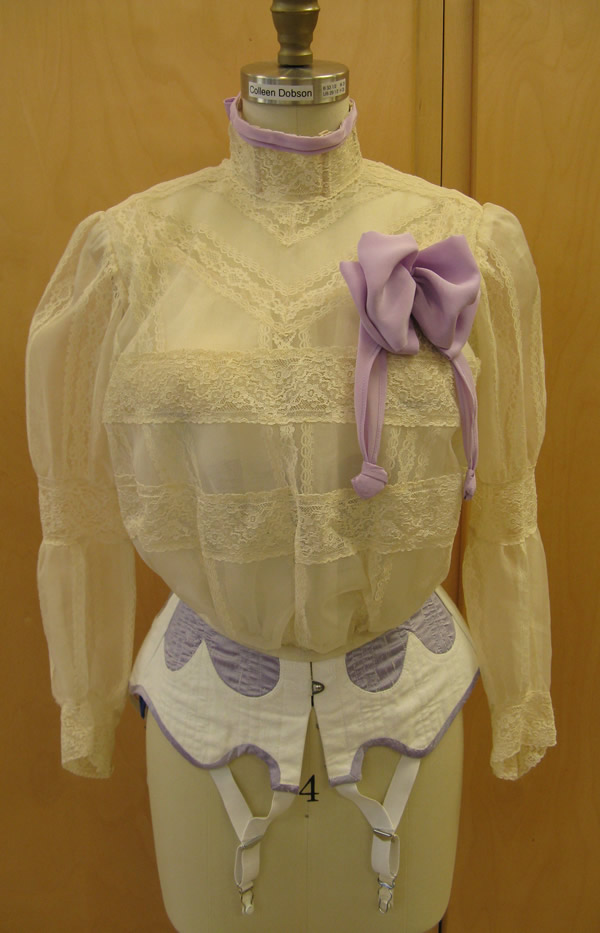The reproduction of this bodice was created for a modern body of a larger size than the original. The original garment has a waist measurement of 22" and the reproduction has been scaled to fit a 27" waist. The dress form measured 38" at the bust, 27" at the waist, and 36" at the hip. Because organdy of such a fine weight as used in the original bodice is difficult to obtain, the reproduction was made of a natural-colored silk organza, which has a sheer quality and hand similar to organdy. The lace in the reproduction was selected based on width and the weight of the threads used in the weaving process. Both laces used in the reproduction, one 2 1/4" wide and the other 1 3/4" wide, were dyed to match the silk organza.
Figure 1: Reproduction Front |
Figure 2: Reproduction Back |
 |
 |
The pattern for the reproduction was draped on a standard size 4 dress form with padded bust over which was placed a reproduction of a corset dated to 1906, as seen in Figure 3 below.
Figure 3: 1906 CorsetReproduction |
 |
The inner bodice was constructed using French seams rather than having the seams turned inward to be finished. The bones are straight steel covered in nylon Prussian tape and stitched along the side of the casing to the seams. The side seam bones are inserted into the pocket created by the French seam. The center back closes with a row of hooks and loops with a single bone inserted on the loop side. A twill tape and drawstring finish the neckline of the inner bodice. An interior waist band has been cross-stitched to the center front bone casing. Thread chain belt carriers which are not apparent in the original have been added to the side seams to help control the function of the waist band.
The middle layer bolster was made from the same organza. The effect of the bolster can be seen below in Figure 4. While in the original garment this piece continued across the front in a straight line, the reproduction was shaped to echo the curve upward at the armscye and shoulder. This made the alignment of all the layers at the armscye simpler as well as making the gathers across the top of the bolster easier to control.
Figure 4: Reproduction Side |
 |
The exterior bodice was cut out of organza and then sewn together at the side seams. The lace was then applied to the organza using a small machine stitch. The organza and excess lace was cut away from the back of the lace pieces. Lace was applied over the side seams which meant that when the organza was cut away, the seam disappeared with it. During assembly, the purpose of the 1/2" darts under the lace at the front shoulder on the original garment was made clear. While the bodice pieces lined up nicely when flat on a table, fullness in the exterior layer appeared in the front armhole area once the garment was put onto a body. While fitting the reproduction, those darts were eliminated from the final product.
The sleeves of the garment had a gusset added to increase the range of motion available to the wearer. The cuff is closed at the underarm seam with three rings covered in silk thread and corresponding thread-chain loops, as seen in Figure 5 below.
Figure 5: Sleeve Cuff withHand-crocheted Buttons |
 |
The collar is made from a single layer of lace which has been starched and pressed into a curve. It has five 2" bones supporting it. The top edge is covered with a bias strip of lavender crepe de Chine and matching bow. Lavender was selected instead of the original mint green to match the corset reproduction that is worn under the reproduction bodice. The larger bow on the front left breast is made from the same lavender crepe de Chine.
The original bodice was meant to be worn with the bottom edge tucked under the shaped waistband of a skirt but the reproduction was patterned to go over a skirt. This means that the twill-weave ribbon that was applied to the outside of the original bodice was not incorporated into the reproduction.
© Colleen Dobson, 2015

